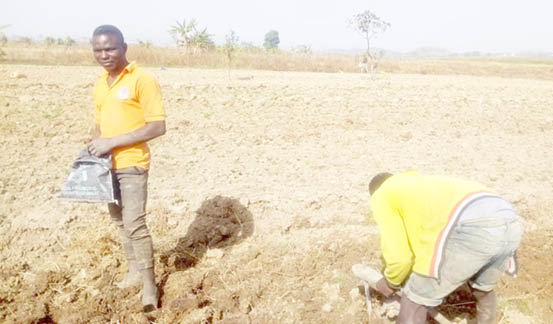Rainfall: Why farmers should not rush to plant
In the last few days, some areas in the northcentral have been witnessing rainfall and the temptation for farmers to rush to plant their crops is likely high. It is important that the farmers take seriously, the prediction by NiMet regarding rainfall. During the presentation of the 2023 seasonal prediction in January, the Minister of […]

Farmers planting during the irrigation planting season on the outskirt of Bwari in the FCT
In the last few days, some areas in the northcentral have been witnessing rainfall and the temptation for farmers to rush to plant their crops is likely high.
It is important that the farmers take seriously, the prediction by NiMet regarding rainfall.
During the presentation of the 2023 seasonal prediction in January, the Minister of Aviation, Sen. Hadi Sirika, and the Director General of NiMet, Mansur Matazu, envisaged early onset of rainfall in parts of the country, which was expected to become established in early March from the coastal states of Bayelsa, Rivers and Akwa Ibom; in April for the inland states of the south; in May around the central states and around July in the northern states.
Going by the prediction, the central states like Abuja, Nasarawa and Plateau which are currently experiencing rainfall must exercise caution as rainfall was predicted to likely establish between April and May.
- 47 years after creation, Idoma people beg for Benue gov’ship
- Old naira notes remain legal in Bayelsa till December 31 – Govt
According to the forecast, there will likely be an early end of season (EoS) over sections of the south, particularly in Osun, Ondo, Edo, Delta, Imo, Bayelsa, Rivers, Akwa Ibom, and the eastern portions of Ogun and Lagos, as well as portions of Yobe, Adamawa, Niger, Nasarawa and Kogi. Across portions of Gombe, Kaduna, Kwara, Enugu, Anambra, western Ogun and Lagos, a prolonged rainy season is anticipated. The predicted EoS period is from September to December 25.
Except for some regions of the northern states like Katsina, Jigawa and Kano, where shorter than the long-term average growing season length is forecast, the length of the growing season is likely to be close to the long-term average in most areas of the nation. The anticipated length of the season is between 84 and 283 days. Between 170 and 230 days are anticipated in Abuja and the adjacent regions.
Throughout the majority of the country, it is anticipated that the annual total rainfall will be between normal and above normal. On the other hand, it is probable that areas of Yobe, Jigawa, Kano, Bauchi, Jigawa, Kaduna, and FCT would experience below-normal to near-normal annual rainfall quantities. The quantity of yearly precipitation is anticipated to vary from 420 mm in the farthest northern regions to 3253 mm in the coastal regions.
Nonetheless, in recent years, our seasons have been marked by instances of dry spells, especially from the center regions of the country to the north. We should be prepared for its occurrence in 2023 between June and early July as a dry spell lasting between 15 and 21 days.
The “little” dry season (also known as “August Break”) is predicted to be less severe than in previous years and to last between 14 and 20 days commencing in late July, with the southwestern region of the country being most affected.
Prof. Mohammed Faguji, Executive Director of the Institute of Agricultural Research, IAR Zaria, recommended late May and early June as the ideal dates to plant grains for the majority of Nigeria’s savanna regions.
He stated that areas like southern Katsina, Zamfara, Kaduna, and Federal Capital Territory are the areas, which fall under the savanna regions in the nation.
Faguji emphasized that cowpea (beans) planting should begin around July 22 and that planting of legumes like groundnut and soybeans should come almost soon after planting cereals.
